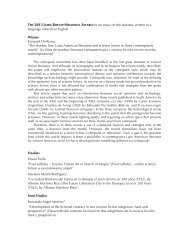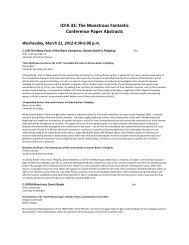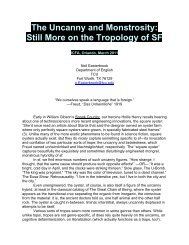The Monstrous Fantastic Conference Paper Abstracts - International ...
The Monstrous Fantastic Conference Paper Abstracts - International ...
The Monstrous Fantastic Conference Paper Abstracts - International ...
You also want an ePaper? Increase the reach of your titles
YUMPU automatically turns print PDFs into web optimized ePapers that Google loves.
146. (F) Challenging Genre Conventions: Wilde, Link, Bakker Captiva BChair: John PenningtonSt. Norbert CollegePainting Dorian and Christening Jack: Identity and Fantasy in <strong>The</strong> Picture of Dorian Gray and <strong>The</strong> Importance of Being EarnestJude WrightUniversity of South FloridaIn my paper I argue that that <strong>The</strong> Picture of Dorian Gray and <strong>The</strong> Importance of Being Earnest have been inadequately read together and thatEarnest should be viewed as a cousin to Dorian Gray. Both are in part about the art of "Bunburrying" and take as their point fantastic narrativesor objects which take over realist ones. Read in conjunction the two works address central issues in contemporary theory, particularly whenexamined in the critical lights of Jean Baudrillard and Judith Butler. Joyce Carol Oates and Nils Clausson both argue that Dorian Gray achievesits effects by mixing genres, mapping (in my phrase) the fantastic genre of the Gothic onto of another genre--for Oates it is a kind of restorationcomedy, while for Clausson it is the Paterian narrative of self-development. Yet, I would argue, the novel's primary power is in the way that theGothic overpowers the more ordinary world of the other genre. In Dorian Gray the narrative of Dorian's crimes becomes etched on the object.<strong>The</strong> art object and the reality it represents somehow switch places. Through this destructive mapping of fantasy narrative onto realism in Wildeserves as a precursor to Baudrillard who suggest that modern Western culture has replaced the signified with the sign. Baudrillard's argumentsregarding over-signification and the creation of simulacra may be seen as objections to non-realist narrative elaborated upon the real. DorianGray seems to acknowledge and embrace this critique. However, <strong>The</strong> Importance of Being Earnest offers a response to this critique, pointing tothe fact that while Baudrillard distrusts such usages of narrative, which ultimately function to create simulacra and undermine the signified,these fantastic narrative uses can also be creative and liberating. In this Wilde has understood both the destructive potential for the fantasywhen linked to identity, but also its creative potential. Wilde's representation of this creative mapping of fantastic narratives onto daily lives inEarnest in some sense pre-figures feminist critiques of Baudrillard, particularly those of Judith Butler. For Butler, Baudrillard's formulationignores the role that performance plays in identity, and it is this performance that is at the heart of Wilde's theories of identity and can befound in many of his major works. It is most prominent in Earnest where identity is entirely built around performance in a way which is itselffantastic.In Medias Genre: Genre as <strong>Fantastic</strong> Space in the Fictions of Kelly LinkPedro PonceSt. Lawrence University<strong>The</strong> distinct hybridity of Kelly Link’s fictions, in which fantasy and science fiction mingle with the fairy tale and detective story, goes beyondmere allusion or homage. Link appropriates genre conventions in order to interrogate the narrative and cultural assumptions that informliterary realism; to the charge that genre fiction lacks verisimilitude, Link’s stories respond through the limits and possibilities revealed whenthe ostensibly real is permeated by the conventionally unreal. Genre in Link is treated as space rather than text; her fictions brim with artifactsand settings associated with specific genres: magic shoes (“Travels with the Snow Queen,” “Shoe and Marriage”); haunted houses (“<strong>The</strong>Specialist’s Hat,” “Stone Animals”); charmed beasts (“Water Off a Black Dog’s Back,” “Stone Animals”). While Link’s stories often begin inrealistic settings, they are frequently disrupted by the physical intrusions of genre elements into the discourse. Her plots begin not so much inmedias res as in medias genre. This paper will explore Link’s fiction through the critical lens of Mikhail Bakhtin. In his concepts of thechronotope, the distinct space and time associated with narrative, and the carnivalesque, the implications for narrative of the multivalentcarnival, Bakhtin helps to illuminate a poetics fundamental to Link, a representative voice in the resurgence of the literary fantastic incontemporary American fiction.Passing as the Hero: Rituals of Moral Estrangement in R. Scott Bakker’s <strong>The</strong> Darkness That Comes BeforeJosh PearsonUniversity of California, RiversideI argue that R. Scott Bakker’s <strong>The</strong> Darkness That Comes Before engages with Fantasy’s moral and generic conventions by deploying a monstrous,inhuman protagonist. In contrast to common genre intervention strategies that problematize categories of Monster and Hero, Bakker’sprotagonist, Kellhus, is neither a sympathetic monstrous outsider, nor a romanticized anti-hero. His is a sociopathic, anti-humanist subject whoenacts the heroic in bad faith. By portraying the monstrous as colonizing—but still effectively replicating—heroism, the text estranges readersfrom the genre’s implicit moral investments. This monstrous hero collapses generic conventions of heroism Brian Stableford indexes in “ToBring in Fine Things.” Stableford argues (673) that in <strong>Fantastic</strong> texts “the protagonist becomes a hero when the problem with which he is facedis not merely his own, but that of the larger group.” Further, “a hero operates on behalf of others; his projects have a moral weight for thewhole community.” Bakker’s protagonist splinters the logic that binds these assertions. While Kellhus “heroically” aligns himself against theenemies of humanity, he explicitly rejects working on behalf of others. Further, the “moral weight” he places on the community is stronglynegative. In pursuit of his own ends, Kellhus only incidentally serves humanity, and the logics of heroism Stableford identifies run into issues ofinterpretation and intentionality the reader must attempt to resolve. Stableford identifies a related site of intervention when he argues<strong>Fantastic</strong> texts offer narrative pleasure by providing spectacles of good’s victory over evil, which serve as “ritual[s] of moral affirmation” for thereader (672). By placing a monstrous amorality at the locus of “the good”, Bakker’s text offers instead a ritual of moral estrangement. Moralaffirmation is displayed, offered, but withheld, implicating readers’ own desires for the pleasure of moral clarity, desires made conscious andmarked for critical reflection.





